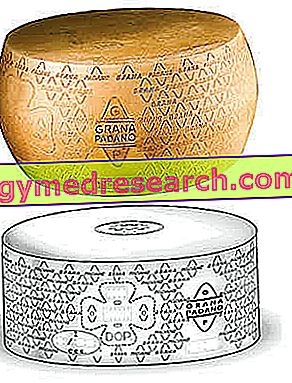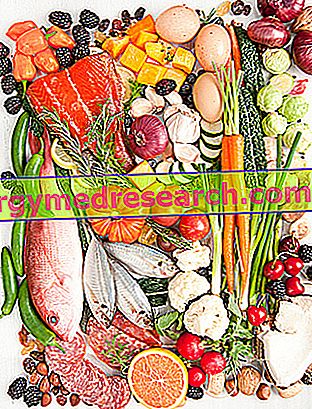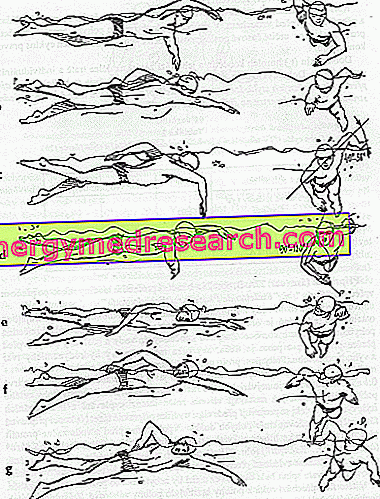Generality
Grana padano, also known as Piacentino, is a dairy product typical of northern Italy; more precisely, its origins can be placed in the area between the river Adda, the river Mincio, the river Po and the Milanese latitude.

The nutritional properties of Grana Padano are discrete. It is an excellent source of calcium, phosphorus and high biological value proteins; on the other hand, it brings high amounts of calories, sodium chloride and glutamate. The latter substance, widely used by the food industry as a flavor enhancer, develops naturally during the maturing of the Grana Padano cheese.
Background
The birth of the Grana Padano could be located approximately around the year 1000 AD. The discovery is attributable to the Catholic monastic order of the Cistercians of Chiaravalle who, reclaiming the Lombardy forests, promoted agriculture and cow breeding (probably the Red Reggiana) locals. Obviously, the large pastures also provided considerable quantities of highly perishable fresh milk (in those days, modern methods of preservation could not be used). Precisely from this need to keep the animal liquid at its best, and for as long as possible, the monks adopted the cheese making of the caseus vetus (old cheese), which only in 1951 would have become the Grana Padano.
The product quickly gained a great reputation, consequently it was widespread first in the surrounding areas, then in all the territories outside the Po. Some finds from 1334 mention the Grana Padano among the foods used in the galleys of long maritime navigation, while in 1477 it became part of the treatise on cheeses of the Sabaudian doctor Pantaleone da Confienza.
Production
The Grana Padano recipe still respects the ancient traditions of the Cistercian monks (obviously, in compliance with some hygienic-sanitary adjustments).
The animals most used for milk production are (to date) the Frisian cows (black Pezzate); these cows are fed mainly from fodder, green or preserved, obtained from company crops or in the area of production of Grana Padano PDO milk. The production disciplinary provides for milking to take place at least twice a day. Thus collected, the milk for cheese production remains raw but is partially skimmed by natural surfacing. The curdling is obtained in copper boilers with a capacity of about 1, 000 liters, from which only two forms of Grana Padano can be obtained. The resulting curd is then broken into small pieces, purged and heated to 55 ° C. The compound is then divided into the appropriate molds, which emboss the marks of origin, for at least 48 hours. It is then dipped in brine for about a month. Once drained, the salted curds are left to mature in special rooms with a constant temperature of 18-20 ° C and humidity of 85%.
| Nutritional composition of Grana Padano - Reference values of the INRAN Food Composition Tables | ||||||||||||||||||||||||||||||||||||||||||||||||||||||||||||||||||||||||||||||||||||||||||||||||||||||||||||||||||||||||||||||||||||||||||||
 | ||||||||||||||||||||||||||||||||||||||||||||||||||||||||||||||||||||||||||||||||||||||||||||||||||||||||||||||||||||||||||||||||||||||||||||
Nutritional values (per 100 g of edible portion) | ||||||||||||||||||||||||||||||||||||||||||||||||||||||||||||||||||||||||||||||||||||||||||||||||||||||||||||||||||||||||||||||||||||||||||||
| ||||||||||||||||||||||||||||||||||||||||||||||||||||||||||||||||||||||||||||||||||||||||||||||||||||||||||||||||||||||||||||||||||||||||||||
At the cross section, the grana padano is circular; in its entirety, instead, it looks more like a cylindrical and flattened block. The diameter of the shape is between 35 and 45 centimeters, while the height is 18-25 centimeters and the weight fluctuates between 24 and 40 chylons.
As we have seen, the shapes immediately receive the mark of the four-leaf clover (identification code) but only after maturation (12 months, 24 months and beyond, a period in which they are turned over and dusted), we proceed to the lozenge of the wording "Grana Padano" . If the product does not have the required characteristics, instead proceed with the cancellation of the origin marks stamped by the molds.
The main evaluation criteria for the suitability of the cheese, adopted by the commission of internal inspectors, are: the absence of "voids" (verified with a hammer) and the typical taste of the food (tasted by drilling a drill in the form ).
The only exception for the wording of the lozenge is represented by the "Grana Trentino", properly regulated and characterized by the use of grazing cows in the alpine valleys.
Discover the Video Recipe of homemade grated "Vegan Cheese"
Physical, Organoleptic and Gustative Characteristics of Grana Padano
The Grana Padano cheese is a hard consistency, so much so that it should NOT be cut, but rather "broken" by means of the special "drop" knife / awl. The color of the pasta ranges from white to straw-colored and pale yellow (in the more seasoned ones). The aroma of Grana Padano is typical, the taste is elegant and particularly sapid.
In the kitchen, grana padano lends itself to grating and, in addition to being part of different recipes or doughs, accompanies many types of first courses, appetizers, side dishes and dishes. It also lends itself as a meal cheese and as a more complex food pairing.
See examples of recipes with grated Parmesan cheese
The most suitable wine-making approach is with wines like: Amarone della Valpollicella, Barolo Spers and Marquis of Villamarina.
Nutritional Properties
In its category (cheeses), grana padano is considered among the most digestible of all; however, this does NOT mean that it is a light and easily digestible food in an absolute sense. Its primary nutritional characteristics are:
- Lactose deficiency, despite being a derivative of milk
- Richness in high biological value proteins
- Calcium and phosphorus richness
- Riboflavin richness (vit. B2)
- Equivalent retinol richness (pro-vit. A)
- Medium fat intake (minimum 32% on dry matter), as it comes from partially skimmed cow's milk
- Significant presence of cholesterol
- Plenty of total calories
- Excess sodium
- Excess of sodium glutamate (flavor enhancer).
The low presence of lactose is due to the long maturation, during which the microorganisms involved in the process use the disaccharide for their cellular metabolism. The proteins, of high biological value, are partially hydrolysed, therefore more digestible than those of milk.
Calcium, phosphorus, riboflavin, retinol, total fat and calories are the result of the "concentration" caused by the relative dehydration (curd, salting and maturing) of the cheese; the nutritional content is as rich and concentrated as it is "mature".
Unfortunately, the Grana Padano owes its preservability to the massive presence of sodium and part of its taste to that of glutamate.
Grana Padano is a food that, always in addition to first courses (about 5-10g) or 1-2 times a week as a dish (70-80g), can be easily contextualized in any diet. Its main function is to increase the intake of calcium and riboflavin, which is why we recommend using it in the growth phase. It is however necessary to keep in mind that it is a product that is remarkably rich in sodium (harmful for arterial hypertension), cholesterol (harmful for hypercholesterolemia) and glutamate (potentially harmful for allergic or hypersensitive people).
Stuffed Grana Baskets with Bulgur Salad
X Problems with video playback? Reload from YouTube Go to Video Page Go to Video Recipes Section Watch the video on youtube



